| Tendaguru Formation | |
|---|---|
| Stratigraphic range: ?Callovian-Hauterivian ~ | |
.jpg.webp) | |
| Type | Geological formation |
| Sub-units | See text |
| Underlies | Makonde Formation |
| Overlies | Neoproterozoic gneiss basement |
| Thickness | >110 m (360 ft) |
| Lithology | |
| Primary | Sandstone |
| Other | Shale, siltstone, clay, conglomerate, limestone |
| Location | |
| Coordinates | 9°42′S 39°12′E / 9.7°S 39.2°E |
| Approximate paleocoordinates | 29°24′S 16°42′E / 29.4°S 16.7°E |
| Region | Lindi Region |
| Country | |
| Extent | Mandawa Basin |
| Type section | |
| Named for | Tendaguru Hill |
| Named by | Janensch & Hennig |
| Year defined | 1914 |
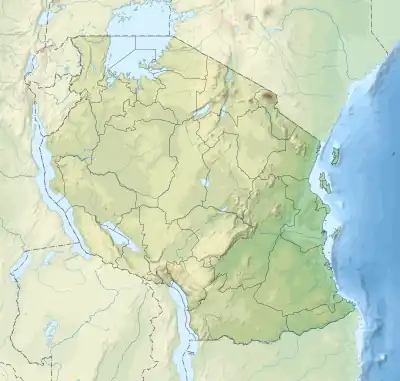 Tendaguru Formation (Tanzania) | |
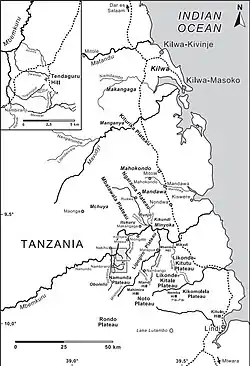
The Tendaguru Formation, or Tendaguru Beds are a highly fossiliferous formation and Lagerstätte located in the Lindi Region of southeastern Tanzania. The formation represents the oldest sedimentary unit of the Mandawa Basin, overlying Neoproterozoic basement, separating by a long hiatus and unconformity. The formation reaches a total sedimentary thickness of more than 110 metres (360 ft). The formation ranges in age from the late Middle Jurassic to the Early Cretaceous, Oxfordian to Hauterivian stages, with the base of the formation possibly extending into the Callovian.
The Tendaguru Formation is subdivided into six members; from oldest to youngest Lower Dinosaur Member, the Nerinella Member, the Middle Dinosaur Member, Indotrigonia africana Member, the Upper Dinosaur Member, and the Rutitrigonia bornhardti-schwarzi Member. The succession comprises a sequence of sandstones, shales, siltstones, conglomerates with minor oolitic limestones, deposited in an overall shallow marine to coastal plain environment, characterized by tidal, fluvial and lacustrine influence with a tsunami deposit occurring in the Indotrigonia africana Member. The climate of the Late Jurassic and Early Cretaceous was semi-arid with seasonal rainfall and the eustatic sea level was rising in the Late Jurassic from low levels in the Middle Jurassic. Paleogeographical reconstructions show the Tendaguru area was located in the subtropical southern hemisphere during the Late Jurassic.
The Tendaguru Formation is considered the richest Late Jurassic strata in Africa. The formation has provided a wealth of fossils of different groups; early mammaliaforms, several genera of dinosaurs, crocodyliforms, amphibians, fish, invertebrates and flora. More than 250 tonnes (250 long tons; 280 short tons) of material was shipped to Germany during early excavations in the early twentieth century. The faunal assemblage of the Tendaguru is similar to the Morrison Formation of the central-western United States, with an additional marine interbed fauna not present in the Morrison.
The dinosaur fauna found in the formation is similar to that of other highly fossiliferous stratigraphic units of the Late Jurassic; among others the Kimmeridge and Oxford Clays of England, the Sables de Glos, Argiles d'Octeville, Marnes de Bléville of France, the Alcobaça, Guimarota and Lourinhã Formations of Portugal, the Villar del Arzobispo Formation of Spain, the Shishugou, Kalazha and Shangshaximiao Formations in China, the Toqui Formation of Chile and Cañadón Calcáreo Formation and the Morrison Formation, with the presence of dinosaurs with similar counterparts, e.g., Brachiosaurus and Stegosaurus in the Morrison, and Giraffatitan and Kentrosaurus in the Tendaguru.[1]
Description

The Tendaguru Formation represents the oldest sedimentary unit in the Mandawa Basin, directly overlying Neoproterozoic basement consisting of gneiss. The contact contains a large hiatus, a missing sequence of stratigraphy, spanning the Paleozoic, Triassic and Early Jurassic. The formation is unconformably overlain by late Early Cretaceous sediments of the Makonde Formation, that forms the top of several plateaus; Namunda, Rondo, Noto, and Likonde-Kitale.[2]
Based on extended geological and paleontological observations the "Tendaguruschichten" (Tendaguru Beds) were defined by Werner Janensch as expedition leader and Edwin Hennig in 1914 to define a sequence of Late Jurassic to Early Cretaceous strata, exposed in the Tendaguru area, which is named after Tendaguru Hill.[3]
Stratigraphy
The Tendaguru is divided into 6 members, which represent different depositional environments, with the 'Dinosaur Beds' representing terrestrial facies while the beds with genus/species names represent marine interbeds with shallow marine to lagoonal facies. In ascending order these are: the Lower Dinosaur Member, the Nerinella Member, the Middle Dinosaur Member, Indotrigonia africana Member, the Upper Dinosaur Member, and the Rutitrigonia bornhardti-schwarzi Member.[4]
| Formation | Time period | Member | Lithology | Thickness | Image | ||
|---|---|---|---|---|---|---|---|
| Makonde | Early Albian Aptian |
Fine to medium grained sandstones, intercalated conglomerates, siltstones and claystones | ~200 m (660 ft) | ||||
| Barremian | Unconformity | ||||||
| Tendaguru | Hauterivian Valanginian |
Rutitrigonia bornhardti-schwarzi | Fine to medium grained sandstones with basal conglomerate | 5–70 m (16–230 ft) |  | ||
| Berriasian | Unconformity | ||||||
| Tithonian | Upper Dinosaur | Ripple cross bedded fine grained sandstones and siltstones with intercalated claystone and micritic carbonates | ~32 m (105 ft) | 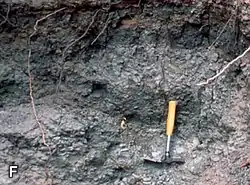 | |||
| Indotrigonia africana | Calcite cemented sandstones, conglomerate beds, thin clay and silt layers with sandy limestones | 20–50 m (66–164 ft) | 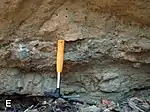 | ||||
| Late Kimmeridgian | |||||||
| Middle Dinosaur | Ripple cross bedded fine grained calcareous sandstones and siltstones and massive to crudely bedded silt and claystones | 13–30 m (43–98 ft) | 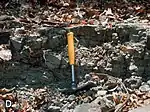 | ||||
| Kimmeridgian Oxfordian |
Nerinella | Trough cross bedded sandstone to massive sandstone | 5–45 m (16–148 ft) | 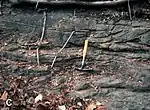 | |||
| Mid Oxfordian ?Callovian |
Lower Dinosaur | Cross bedded fine grained sandstones and siltstones, with Interbedded clay-rich siltstones | >20 m (66 ft) | ||||
| Early Jurassic | Hiatus | ||||||
| Triassic | |||||||
| Paleozoic | |||||||
| Basement | Neoproterozoic | Gneiss | |||||
Paleogeography and depositional environment
Paleogeography

The Tendaguru Formation was deposited in the Mandawa Basin, a post-Karoo,[6] Mesozoic rift basin located between the Ruvu Basin and Rufiji Trough to the north and the Ruvuma Basin to the south.[7] To the west of the basin, Archean and Early Proterozoic basement rocks crop out.[8] The main rift phase in present-day southeastern Africa led to the separation of Madagascar and the then-connected Indian subcontinent happened during the Early Cretaceous.[9] The Songo Songo and Kiliwani gas fields are located just offshore the basin.[10][11]
At time of deposition was undergoing a semi-arid climate with coastal influences that maintained somewhat higher moisture levels than seen inland.[12] The upper parts of the formation, the Middle Dinosaur and Rutitrigonia bornhardti-schwarzi Members in particular, showed prevailing semiarid conditions with pronounced dry seasons, based on palynologic analysis.[13] The Tendaguru fauna was stable through the Late Jurassic.[14]
During the Late Jurassic and Early Cretaceous, the Gondwana paleocontinent was breaking up and the separation of the Laurasian and Gondwana supercontinents resulted from the connection of the Tethys Ocean with the proto-Atlantic and the Pacific Ocean. In addition, the South Atlantic developed towards the end of the Late Jurassic with the separation of South America and Africa. Africa became increasingly isolated from most other continents by marine barriers from the Kimmeridgian into the Early Cretaceous, but retained a continental connection with South America. Global sea levels dropped significantly in the Early Jurassic and remained low through the Middle Jurassic but rose considerably towards the Late Jurassic, deepening the marine trenches between continents.[15]
Depositional environment
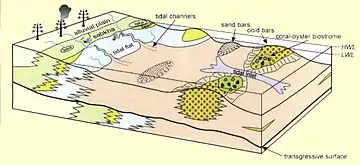
HWL - high water line, LWL - low water line
The sedimentary rocks and fossils record a repeated shift from shallow marine to tidal flat environments indicating that the strata of the Tendaguru Formation were deposited near an oscillating strandline which was controlled by sea level changes. The three dinosaur-bearing members are continental to marginal marine and the three sandstone-dominated members are marginal marine in origin.[16]
- Nerinella Member
The composition of benthic molluscs and foraminifera, euhaline to mesohaline ostracods, and dinoflagellate assemblages indicate marine, shallow water conditions for the Nerinella Member, in particular for the lower part. Sedimentation occurred as tidal channel fills, subtidal and tidal sand bars, minor storm layers (tempestites), and beach deposits. Overall, the Nerinella Member represents a variety of shallow subtidal to lower intertidal environments influenced by tides and storms.[17]
- Middle Dinosaur Member
The sedimentological characteristics of the basal part of the Middle Dinosaur Member suggest deposition on tidal flats and in small tidal channels of a lagoonal paleoenvironment. The ostracod Bythocypris sp. from the member indicates polyhaline to euhaline conditions. Slightly higher up, a faunal sample dominated by the bivalve Eomiodon and an ostracod assemblage composed of brackish to freshwater taxa is indicative of a brackish water paleoenvironment with distinct influx of freshwater as revealed by the nonmarine ostracod genus Cypridea, charophytes, and other freshwater algae. The paleoenvironment of the ostracod assemblages of the Middle Dinosaur Member changed upsection from a marine setting in the basal parts through alternating marine-brackish conditions to freshwater conditions in the higher parts of this member.[17] The highly sporadic occurrence, in this part of the section, of molluscs typical of marginal marine habitats indicates only a very weak marine influence,[18] at sabkha-like coastal plains with ephemeral brackish lakes and ponds are recorded in the upper part of the Middle Dinosaur Member. This part also contains pedogenic calcretes indicating subaerial exposure and the onset of soil formation.[17] The calcrete intraclasts within adjacent sandstone beds testify to erosive reworking of calcrete horizons.[18] The presence of crocodyilforms indicates freshwater to littoral environments and adjacent terrestrial areas.[19]
- Indotrigonia africana Member
The coarse-grained sandstone of the lower part of the Indotrigonia africana Member that shows highly variable transport directions is interpreted as deposits of large tidal channels. Grain-size, large-scale sedimentary structures, and the lack of both trace fossils and epifaunal and infaunal body fossils suggest high water energy and frequent reworking. This basal succession passes upward in cross-bedded sandstone and minor siltstone and claystone with flaser or lenticular bedding that are interpreted as tidal flat and tidal channel deposits. Horizontal to low-angle cross-bedded, fine-grained sandstone with intercalated bivalve pavements indicates tidal currents that operated in small flood and ebb tidal deltas and along the coast. Stacked successions of trough cross-bedded, medium- to coarse-grained sandstone of the upper part of the Indotrigonia africana Member are interpreted as tidal channel and sand bar deposits. At some places in the surroundings of Tendaguru Hill, these sediments interfinger with oolitic limestone layers that represent high-energy ooid shoals.[17]
In the Tingutinguti stream section, the Indotrigonia africana Member exhibits several up to 20 centimetres (7.9 in) thick, poorly sorted, conglomeratic sandstone beds. They contain mud clasts, reworked concretions and/or accumulations of thick-shelled bivalves (mainly Indotrigonia africana and Seebachia janenschi), and exhibit megaripple surfaces. These conglomeratic sandstone layers are interpreted as storm deposits. In the Dwanika and Bolachikombe stream sections, and in a small tributary of the Bolachikombe creek, a discrete, up to 70 centimetres (2.3 ft) thick conglomerate in the lower portion of the Indotrigonia africana Member displays evidence of a tsunami deposit. Overall, lithofacies and the diverse macroinvertebrate and microfossil assemblages of the Indotrigonia africana Member suggest a shallow marine environment. Based on the diverse mesoflora and the abundance of Classopollis, a nearby vegetated hinterland is postulated that was dominated by xerophytic conifers.[17]
- Upper Dinosaur Member
The small-scale trough and ripple cross-bedded fine-grained sandstone at the base of the Upper Dinosaur Member is interpreted as tidal flat deposits. Unfossiliferous sandstone in the upper part was most likely deposited in small fluvial channels in a coastal plain environment, whereas argillaceous deposits were laid down in still water bodies such as small lakes and ponds. Rare occurrences of the ostracod Cypridea and charophytes signal the influence of freshwater, whereas the sporadic occurrence of marine invertebrates suggests a depositional environment close to the sea.[17]
- Rutitrigonia bornhardti-schwarzi Member
Fining upward sequences of the basal part of the Rutitrigonia bornhardti-schwarzi Member are interpreted as tidal channel fills, the overlying fine-grained sandstone, silt- and claystone as tidal flat deposits. From the immediate surroundings of Tendaguru Hill, invertebrates and vertebrates are poorly known and limit the palaeoenvironmental interpretation of this member. The composition of the land-derived sporomorph assemblage suggests a terrestrial vegetation which was dominated by cheirolepidiacean conifers in association with ferns.[16]
Excavation history
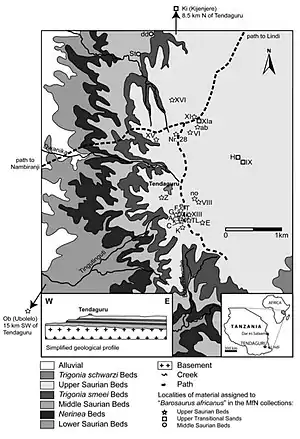
The Tendaguru Beds as a fossil deposit were first discovered in 1906, when German pharmacist, chemical analyst and mining engineer Bernhard Wilhelm Sattler, on his way to a mine south of the Mbemkure River in German East Africa (today Tanzania), was shown by his local staff enormous bones weathering out of the path near the base of Tendaguru Hill, 10 kilometres (6.2 mi) south of Mtapaia (close to Nambiranji village, Mipingo ward, 60 kilometres (37 mi) northwest of Lindi town).[3][20] Because of its morphology, the hill was locally known as "steep hill": "tendaguru" in the language of the local Wamwera people. Sattler sent a report of the discoveries that found its way to German palaeontologist Eberhard Fraas, then on a round trip through Africa, who visited the site in 1907 and with the aid of Sattler recovered two partial skeletons of enormous size.[21]
Following the discovery in 1906, teams from the Museum für Naturkunde, Berlin (1907–1913), and the British Museum (Natural History), London (1924–1931) launched a series of collecting expeditions that remain unequalled in scope and ambition. Led by the vision and influence of geologist Wilhelm von Branca, the German expeditions were particularly successful, in large part because the project was taken up as a matter of national ambition (Germany was then a young nation, having been unified by von Bismarck less than 40 years earlier) and enjoyed the benevolence of many wealthy patrons. Eventually, nearly 250 tons of bones, representing an entirely new dinosaur fauna that remains the best understood assemblage from all of former Gondwana, was shipped to Berlin.[22]
From there, the material was transported to Fraas' institution, the Royal Natural History Collection in Stuttgart, Germany. Fraas described two species in the badly known genus "Gigantosaurus"; G. robustus and G. africanus (today Janenschia robusta and Tornieria africana, respectively).[21]
German Tendaguru Expedition
The Berlin's Natural History Museum excavated at Tendaguru hill and in the surroundings for four years. From 1909 through 1911, Werner Janensch as expedition leader and Edwin Hennig as assistant directed excavations, while Hans Reck and his wife Ina Reck led the 1912 field season. Other European participants include Hans von Staff. In the rainy seasons the scientists explored the geology of the colony German East Africa on long safaris.
Public discussion about provenance and restitution
In the context of international discussion about the provenance and possible restitution of colonial heritage, as discussed for example in the 2018 report on the restitution of African cultural heritage, both German as well as Tanzanian commentators have called the claim to rightful ownership by the Berlin museum into question. The Tanzanian government has, however, not submitted any official demand for repatriation. German authorities have preferred to offer information on the provenance and research by increasing cooperation between Tanzanian paleontologists and museums with their German counterparts.[23]
In popular culture
In 1998, an illustrated book in Swahili, whose title translates as Dinosaurs of Tendaguru, was published for young readers in East Africa. It presents a slightly different, fictitious story of the first discovery, which is attributed to a Tanzanian farmer, rather than to the German engineer Sattler.[24]
Paleontological significance
Possible dinosaur eggs have been recovered from the formation.[25]
The fauna of the Tendaguru Formation has been correlated with the Morrison Formation of the central-western United States,[26] several formations in England, among which the Kimmeridge Clay and Oxford Clay, and France (Sables de Glos, Argiles d'Octeville, Marnes de Bléville), the Alcobaça, Guimarota and Lourinhã Formations of Portugal,[27] the Villar del Arzobispo Formation of Spain, the Shishugou, Kalazha and Shangshaximiao Formations of China, and the Toqui Formation of the Magallanes Basin, Chile and the Cañadón Calcáreo Formation of the Cañadón Asfalto Basin in central Patagonia, Argentina.[28]
Fossil content
Color key
|
Notes Uncertain or tentative taxa are in small text; |
Mammaliaformes
| Mammaliaformes reported from the Tendaguru Formation | ||||||
|---|---|---|---|---|---|---|
| Genus | Species | Location | Member | Material | Notes | Images |
| Allostaffia | A. aenigmatica | Quarry Ig | Middle Dinosaur | Three isolated molars | Originally described as Staffia, later renamed Allostaffia as Staffia was preoccupied bya foraminifer.[29] Assigned to Haramiyida (though possibly a gondwanathere instead).[30] |
|
| Brancatherulum | B. tendagurense | Unspecified | Upper Dinosaur[31] | Dentary without teeth | Either a stem-zatherian or dryolestidan.[32] | |
| Tendagurodon | T. janenschi | Quarry Ig | Middle Dinosaur | Single tooth | One of the earliest amphilestids[33] | |
| Tendagurutherium | T. dietrichi | Quarry Ig | Middle Dinosaur | Partial dentary with damaged last molar | Either a peramurid or an australosphenidan[30] | |
Squamates
| Squamates reported from the Tendaguru Formation | ||||||
|---|---|---|---|---|---|---|
| Genus | Species | Location | Member | Material | Notes | Images |
| Paramacellodidae? | Indeterminate | An osteoderm | Unconfirmed[34] | |||
Pterosaurs
| Pterosaurs reported from the Tendaguru Formation | ||||||
|---|---|---|---|---|---|---|
| Genus | Species | Location | Member | Material | Notes | Images |
| Tendaguripterus | T. recki[35] | Quarry Ig | Middle Dinosaur | A partial mandible with teeth | [35] |  Pterosaur fossils from Tendaguru |
| ?Indeterminate archaeopterodactyloid | Mkoawa Mtwara | Humerus | [35][36] | |||
| Indeterminate azhdarchid | Mkoawa Mtwara | [35] | ||||
| Indeterminate dsungaripteroid | Upper Dinosaur[31] | Humerus | [36] | |||
| Pterodactylus | P. maximus | Mkoawa Mtwara | Later determined to be an indeterminate pterodactyloid[35] | |||
| P. brancai | Mkoawa Mtwara | Tibiotarsi[37] | Later determined to be an indeterminate dsungaripteroid[35] | |||
| P. arningi | Mkoawa Mtwara | Later determined to be an indeterminate pterosaur[35] | ||||
| Rhamphorhynchus | R. tendagurensis | Mkoawa Mtwara | Later determined to be an indeterminate "rhamphorhynchoid"[35] | |||
Ornithischians
| Ornithischians reported from the Tendaguru Formation | ||||||
|---|---|---|---|---|---|---|
| Genus | Species | Location | Member | Material | Notes | Images |
| Dysalotosaurus | D. lettowvorbecki | Quarry Ig | Middle Dinosaur | "Large number of mostly disassociated cranial and postcranial elements" | A dryosaurid[25][38] |  |
| Kentrosaurus | K. aethiopicus | Quarry Q, Ig, St, S, Ny, Li, XX, r, y, d, Ng, X, H, IX, Om, bb, Ha, XIV, II, IV, V, VIII, G, e, g, Ki | Lower, Middle & Upper Dinosaur | "[Two] composite mounted skeletons, [four] braincases, [seven] sacra, more than [seventy] femora, approximately 25 isolated elements, juvenile to adult" | A stegosaur[25][39] |  |
Sauropods
| Sauropods reported from the Tendaguru Formation | ||||||
|---|---|---|---|---|---|---|
| Genus | Species | Location | Member | Material | Notes | Images |
| Australodocus | A. bohetii | Quarry G | Upper Dinosaur | Two neck vertebrae; more undescribed remains destroyed during World War II | [40]Somphospondylan | 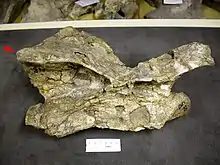 |
| Dicraeosaurus | D. hansemanni | Quarry Q, m, St, dd, Sa | Lower, Middle & Upper Dinosaur | "Skeleton lacking skull and forelimbs, [two] partial skeletons, isolated vertebrae, and limb elements" | Dicraeosaurid[25][41] | |
| D. sattleri | Quarry La, s, O, ab, E, M, o, Ob, bb, XIV, G, GD | Middle & Upper Dinosaur | "[Two] partial skeletons without skulls, isolated postcranial remains" | Dicraeosaurid[25][41] | ||
| Giraffatitan[25] | G. brancai | Quarry Q, J, Ig, Y, St, dd, S, TL, XX, Ma, JR, Ng, Bo, To, p, t, Lw, D, N, ab, cc, X, IX, Z, T, Aa, l, E, XIV, II, G, e, Ki, No, R, F, XII, GD, XV, Sa, U, i | Lower, Middle & Upper Dinosaur | Brachiosaurid. The new genus Giraffatitan was erected to hold the former Brachiosaurus species, B. brancai after scientists concluded that it was distinct enough from the Brachiosaurus type species, B. altithorax, to warrant such a reclassification.[42] | .jpg.webp) | |
| Janenschia | J. robusta | Quarry dd, P, IX, B, G, Oa, NB | Middle & Upper Dinosaur | Known from hindlimb and forelimb material, left pubis and two right ischia | non-neosauropod eusauropod[25][43] |  |
| Tendaguria | T. tanzaniensis | Nambango site | Upper Dinosaur | "[Two] associated cranial dorsal vertebrae" | A turiasaur[25][44] | |
| Tornieria | T. africana | Quarry St, k, MD, A, e, Sa | Middle & Upper Dinosaur | "More than [three] partial skeletons, a few skull elements, [and] many isolated postcranial elements" | Diplodocid[25][45] | |
| Wamweracaudia | W. keranjei | A sequence of caudal vertebrae | Mamenchisaurid[43] | |||
| Brachiosaurus | B. brancai | Mkoawa Mtwara | "[Five] partial skeletons, more than [three] skulls, [and] isolated limb elements" | B. brancai was distinct enough from the non-Tendaguru Brachiosaurus type species B. altithorax that it was moved to its own genus, Giraffatitan.[25][42][46] | ||
| B. fraasi | Remains attributed to B. fraasi were later referred to B. brancai, and thus now Giraffatitan[25][42] | |||||
| Diplodocinae indet. | Indeterminate | Kijenjere | Upper Dinosaur | Partial skull | Belonging to a form that is closely related to Diplodocus[47] | 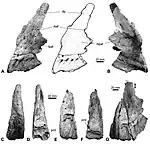 |
| Diplodocidae indet. | Indeterminate | Kijenjere | Upper Dinosaur | Caudal vertebrae and metatarsal | Originally referred to as "Barosaurus africanus"[48] | _-_Tendaguru_Formation.jpg.webp) |
| Diplodocidae indet. | Indeterminate | Trench XIV | Upper Dinosaur | Articulated pedes | Possibly representing two different taxa[49] |  |
| Flagellicaudata indet. | Indeterminate | Upper Dinosaur | Braincase | Referred to Flagellicaudata indet. based on the derived characters shared with this group[50] |  | |
| "The Archbishop" | Brachiosaur, distinct from Giraffatitan[note 1] | 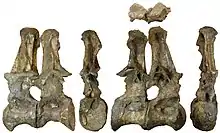 | ||||
Theropods
| Theropods reported from the Tendaguru Formation | ||||||
|---|---|---|---|---|---|---|
| Genus | Species | Location | Member | Material | Notes | Images |
| ?Abelisauridae indet. | Indeterminate | Quarry TL | Upper Dinosaur | A left tibia, a right tibia, and a femur[51] | Possibly an indeterminate abelisaurid.[51] | |
| Megalosauroidea indet. | Indeterminate | Quarry MW | Upper Dinosaur | left tibia and left astragalus[51] | A large indeterminate megalosauroid.[51] | |
| Elaphrosaurus | E. bambergi | Quarry Ig, dd, ?RD | Middle Dinosaur, ?Upper Dinosaur | "Postcranial skeleton"[52] | An elaphrosaurine noasaurid[25] | 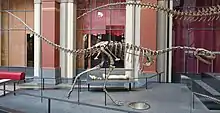 |
| Ostafrikasaurus | O. crassiserratus | Quarry Om | Upper Dinosaur | "Tooth" | A tooth of controverisial affinitiies, had either been suggested to have been a spinosaurid or a ceratosaurid.[53][54] |  |
| Veterupristisaurus | V. milneri | Quarry St | Middle Dinosaur | "Vertebrae" | The earliest known carcharodontosaurid.[51] |  |
| ?Allosaurus | ?A. tendagurensis | Quarry TL | Middle Dinosaur | A tibia[25][55] | Remains now considered "Tetanurae indet." Possibly a megalosauroid or carcharodontosaurid.[51] Originally referred to Allosauridae' |  |
| Ceratosaurus | C. roechlingi | Quarry St, MW | Middle & Upper Dinosaur | Caudal vertebra | Tentatively referred to Ceratosauridae.[51] Originally referred to Allosauridae. |  Ceratosaurus |
| Labrosaurus | L. stechowi | Quarry St, MW | Middle Dinosaur | Teeth | A ceratosaurid, a species of Ceratosaurus.[51] Originally referred to Allosauridae. | |
| ?Torvosaurus | T. sp | Quarry St, MW | Upper Dinosaur | Teeth | Includes remains previously referred to "Megalosaurus" ingens - now known as "Torvosaurus sp".[56] | |
Crocodyliformes
| Genus | Species | Location | Member | Material | Notes | Images |
|---|---|---|---|---|---|---|
| Bernissartia | B. sp | Upper & Middle Dinosaur | [31][57] | |||
Amphibians
| Genus | Species | Member | Notes | Images |
|---|---|---|---|---|
| ?Salientia indet | indeterminate | Middle Dinosaur | [31] | |
Fish
| Genus | Species | Member | Notes | Images |
|---|---|---|---|---|
| Engaibatis | Engaibatis schultzei | Upper Dinosaur | [58] | 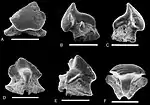 |
| Lepidotes | Lepidotes tendaguruensis | Middle Dinosaur | [31] | |
| L. sp. | Upper & Middle Dinosaur | [59] | 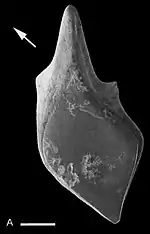 | |
| Hybodus | Hybodus sp. | Upper Dinosaur | [60] |  |
| Lonchidion | Lonchidion sp. | Upper Dinosaur | [61] | 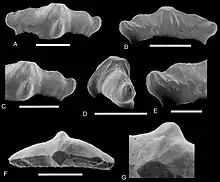 |
| Sphenodus | Sphenodus sp. | Upper Dinosaur | [62] | 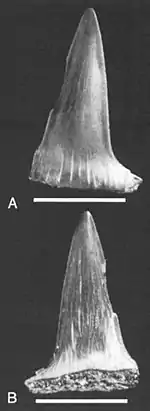 |
Invertebrates
Gastropods
| Genus | Species | Member bold is defining | Notes | Images |
|---|---|---|---|---|
| Pseudomelania | Pseudomelania dietrichi | Middle Dinosaur | [19] | |
| Promathildia | Promathildia sp. | Middle Dinosaur | [19] | |
| Nerinella | Nerinella cutleri | Nerinella | [63] | 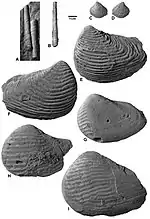 |
Bivalves
| Genus | Species | Member bold is defining | Notes | Images |
|---|---|---|---|---|
| Eomiodon | Eomiodon cutleri | Upper Dinosaur | [64] | |
| Indotrigonia | Indotrigonia africana | Indotrigonia africana | [65] | |
| I. dietrichi | Lower Dinosaur | [66] | ||
| Rutitrigonia | Rutitrigonia bornhardti | Rutitrigonia bornhardti-schwarzi | [64] | |
| R. schwarzi | [64] | |||
| Acesta | Acesta cutleri | Lower Dinosaur | [66] | |
| Actinostreon | Actinostreon hennigi | Indotrigonia africana | [67] | |
| Entolium | Entolium corneolum | Lower Dinosaur | [66] | |
| Falcimytilus | Falcimytilus dietrichi | Middle Dinosaur | [19] | |
| Grammatodon | Grammatodon irritans | Lower Dinosaur | [66] | |
| Liostrea | Liostrea dubiensis | Indotrigonia africana | [67] | |
| L. kindopeensis | Indotrigonia africana | [67] | ||
| Lithophaga | Lithophaga suboblonga | Indotrigonia africana | [67] | |
| Meleagrinella | Meleagrinella radiata | Lower Dinosaur | [66] | |
| Nanogyra | Nanogyra nana | Lower Dinosaur | [66] | |
| Protocardia | Protocardia schenki | Lower Dinosaur | [66] | |
| Seebachia | Seebachia janenschi | Indotrigonia africana | [17] | |
Coral
| Genus | Species | Member bold is defining | Notes | Images |
|---|---|---|---|---|
| Astrocoenia | Astrocoenia bernensis | Indotrigonia africana | [67] | |
| Meandrophyllia | Meandrophyllia oolithotithonica | Indotrigonia africana | [67] | |
| Thamnoseris | Thamnoseris sp. | Indotrigonia africana | [67] | |
Ostracods
| Genus | Species | Member bold is defining | Notes | Images |
|---|---|---|---|---|
| Bythocypris | Bythocypris sp. | Middle Dinosaur | [17] | |
| Cypridea | Cypridea sp. | Middle & Upper Dinosaur | [17] | |
Flora
| Group | Taxa | Member | Notes | Images |
|---|---|---|---|---|
| Araucariaceae | Araucariacites | Lower Dinosaur | [68] | |
| Cheirolepidiaceae | Classopollis | Indotrigonia africana Lower Dinosaur | [17][68] | |
| Cupressaceae | Cupressinoxylon sp. | Rutitrigonia bornhardti-schwarzi | [69] | |
| Cycadaceae | Cycadoxylon sp. | Indotrigonia africana | [70] | |
| Ginkgoaceae | Ginkgoxylon sp. | Rutitrigonia bornhardti-schwarzi | [71] | |
| Taxodiaceae | Glyptostroboxylon sp. | Middle Dinosaur | [69] | |
| Taxaceae | Taxaceoxylon sp. | Rutitrigonia bornhardti-schwarzi | [71] | |
| Prasinophyta | Cymatiosphaera sp. | Indotrigonia africana | [72] | |
| Zygnemataceae | Ovoidites parvus | Middle Dinosaur | [72] | |
| Dinoflagellates | various | Indotrigonia africana Middle Dinosaur | [72] | |
| Gymnosperm pollen | various | Indotrigonia africana Middle Dinosaur | [72] | |
| Pteridophytic and bryophytic spores | various | Indotrigonia africana Middle Dinosaur | [72] | |
See also
- List of stratigraphic units with dinosaur body fossils
- List of African dinosaurs
- Manda Formation, Triassic fossiliferous formation of Tanzania
- Usili Formation, Permian fossiliferous formation of Tanzania
- Mugher Mudstone, Tithonian fossiliferous formation of Ethiopia
- Ksar Metlili Formation, Tithonian to Berriasian fossiliferous formation of Morocco
- Kirkwood Formation, Berriasian to Hauterivian fossiliferous formation of South Africa
- Sundays River Formation, Valanginian to Hauterivian fossiliferous formation of South Africa
- Bajada Colorada Formation, Berriasian to Valanginian fossiliferous formation of Argentina
- Dinosaurs of Tendaguru, Book for young readers in Swahili
Notes and references
Notes
- ↑ Formal description in preparation by Michael Taylor in 2019
References
- ↑ Mateus, 2006, pp.223–232
- ↑ Bussert et al., 2009, p.154
- 1 2 Bussert et al., 2009, p.142
- ↑ Schwarz-Wings & Böhm, 2014, p.82
- ↑ Bussert et al., 2009, p.152
- ↑ Muhongo, 2013, p.28
- ↑ Muhongo, 2013, p.8
- ↑ Muhongo, 2013, p.33
- ↑ Muhongo, 2013, p.3
- ↑ Muhongo, 2013, p.17
- ↑ Muhongo, 2013, p.22
- ↑ Noto & Grossmann, 2010, p.7
- ↑ Schrank, 1999, p.181
- ↑ Noto & Grossmann, 2010, p.9
- ↑ Arratia et al., 2002, p.227
- 1 2 Bussert et al., 2009, p.168
- 1 2 3 4 5 6 7 8 9 10 Bussert et al., 2009, p.167
- 1 2 Aberhan et al., 2002, p.32
- 1 2 3 4 Aberhan et al., 2002, p.33
- ↑ Maier, 2003
- 1 2 Fraas, 1908
- ↑ Cifelli, 2003, p.608
- ↑ Vogel, Gretchen (2019-03-27). "Countries demand their fossils back, forcing natural history museums to confront their past". Science | AAAS. Retrieved 2021-06-15.
- ↑ Maier, Gerhard (2003). African Dinosaurs Unearthed. The Tendaguru Expeditions. Bloomington and Indianapolis (Indiana University Press), p. 304. Indiana University Press. pp. 380, 50 figs. ISBN 0253342147.
- 1 2 3 4 5 6 7 8 9 10 11 12 13 Weishampel et al., 2004, p.552
- ↑ Taylor, 2009, p.790
- ↑ Mateus, 2006, p.1
- ↑ Noto & Grossmann, 2010, p.3
- ↑ Heinrich, 2004
- 1 2 Chimento et al., 2016
- 1 2 3 4 5 Aberhan et al., 2002, p.30
- ↑ Averianov & Martin, 2015, p.327
- ↑ Heinrich, 1998, p.269
- ↑ Evans, Susan E. (2022-08-11), Gower, David J.; Zaher, Hussam (eds.), "The Origin and Early Diversification of Squamates", The Origin and Early Evolutionary History of Snakes (1 ed.), Cambridge University Press, pp. 7–25, doi:10.1017/9781108938891.004, ISBN 978-1-108-93889-1, retrieved 2024-01-11
- 1 2 3 4 5 6 7 8 Barrett et al., 2008
- 1 2 Costa & Kellner, 2009, p.814
- ↑ Galton, 1980
- ↑ "Table 19.1," in Weishampel et al., 2004, p.414
- ↑ "Table 16.1," in Weishampel et al., 2004, p.344
- ↑ Remes, 2007
- 1 2 "Table 13.1," in Weishampel et al., 2004, p.264
- 1 2 3 Taylor, M.P., 2009, pp.787-806
- 1 2 Mannion et al., 2019
- ↑ "Table 13.1," in Weishampel et al., 2004, p.261
- ↑ "Table 13.1," in Weishampel et al., 2004, p.265
- ↑ "Table 13.1," in Weishampel et al., 2004, p.267
- ↑ Remes, 2009, p.26
- ↑ Remes, 2009, p.28
- ↑ Remes, 2009, p.30
- ↑ Remes, 2009, p.34
- 1 2 3 4 5 6 7 8 Rauhut, Oliver W. M. (2011). "Theropod dinosaurs from the Late Jurassic of Tendaguru, Tanzania". Special Papers in Palaeontology. 86: 195–239.
- ↑ "Table 3.1," in Weishampel et al., 2004, p.48
- ↑ Buffetaut, 2012, p.2
- ↑ Soto, Matías; Toriño, Pablo; Perea, Daniel (2020). "Ceratosaurus (Theropoda, Ceratosauria) teeth from the Tacuarembó Formation (Late Jurassic, Uruguay)". Journal of South American Earth Sciences. 103: 102781. Bibcode:2020JSAES.10302781S. doi:10.1016/j.jsames.2020.102781. S2CID 224842133.
- ↑ "Table 4.1," in Weishampel et al., 2004, p.75
- ↑ Soto, Matías; Toriño, Pablo; Perea, Daniel (2020). "A large sized megalosaurid (Theropoda, Tetanurae) from the late Jurassic of Uruguay and Tanzania". Journal of South American Earth Sciences. 98: 102458. Bibcode:2020JSAES..9802458S. doi:10.1016/j.jsames.2019.102458. S2CID 213672502.
- ↑ Bussert et al., 2009, p.164
- ↑ Arratia et al., 2002, p.219
- ↑ Arratia et al., 2002, p.224
- ↑ Arratia et al., 2002, p.213
- ↑ Arratia et al., 2002, p.216
- ↑ Arratia et al., 2002, p.218
- ↑ Bussert et al., 2009, p.159
- 1 2 3 Bussert et al., 2009, p.165
- ↑ Bussert et al., 2009, p.162
- 1 2 3 4 5 6 7 Aberhan et al., 2002, p.27
- 1 2 3 4 5 6 7 Aberhan et al., 2002, p.34
- 1 2 Aberhan et al., 2002, p.25
- 1 2 Kahlert et al., 1999, p.192
- ↑ Kahlert et al., 1999, p.188
- 1 2 Kahlert et al., 1999, p.190
- 1 2 3 4 5 Schrank, 1999, p.173
Bibliography
- Geology
- Aberhan, Martin; Robert Bussert; Wolf-Dieter Heinrich; Eckhart Schrank; Stephan Schultka; Benjamin Sames; Jürgen Kriwet, and Saidi Kapilima. 2002. Palaeoecology and depositional environments of the Tendaguru Beds (Late Jurassic to Early Cretaceous, Tanzania). Fossil Record 5. 19–44. Accessed 2019-04-02.
 Material was copied from this source, which is available under a Creative Commons Attribution 4.0 International License.
Material was copied from this source, which is available under a Creative Commons Attribution 4.0 International License. - Bussert, Robert; Wolf-Dieter Heinrich, and Martin Aberhan. 2009. The Tendaguru Formation (Late Jurassic to Early Cretaceous, southern Tanzania): definition, palaeoenvironments, and sequence stratigraphy. Fossil Record 12(2). 141–174. Accessed 2019-04-01. ISSN 1435-1943
 Material was copied from this source, which is available under a Creative Commons Attribution 4.0 International License.
Material was copied from this source, which is available under a Creative Commons Attribution 4.0 International License. - Muhongo, S. 2013. Tanzania: an emerging energy producer, 1–35. Chatham House, London. Accessed 2019-04-02.
- Paleontology
- Arratia, Gloria; Jürgen Kriwet, and Wolf-Dietrich Heinrich. 2002. Selachians and actinopterygians from the Upper Jurassic of Tendaguru, Tanzania. Fossil Record 5. 207–230. Accessed 2019-04-02.
 Material was copied from this source, which is available under a Creative Commons Attribution 4.0 International License.
Material was copied from this source, which is available under a Creative Commons Attribution 4.0 International License. - Averianov, A.O., and T. Martin. 2015. Ontogeny and taxonomy of Paurodon valens (Mammalia, Cladotheria) from the Upper Jurassic Morrison Formation of USA. Proceedings of the Zoological Institute RAS 319. 326–340. Accessed 2019-04-01.
- Barrett, P.M.; R.J. Butler; N.P. Edwards, and A.R. Milner. 2008. Pterosaur distribution in time and space: an atlas, pp.61-107, in Flugsaurier: Pterosaur papers in honour of Peter Wellnhofer - Hone, D.W.E., and Buffetaut, É. (eds). Zitteliana B 28. 1–264. Accessed 2019-04-01.
- Buffetaut, Éric. 2012. An early spinosaurid dinosaur from the Late Jurassic of Tendaguru (Tanzania) and the evolution of the spinosaurid dentition. Oryctos 10(). 1–8. Accessed 2019-04-01.
- Chimento, Nicholas; Frederico Agnolín, and Agustin Martinelli. 2016. Mesozoic Mammals from South America: Implications for understanding early mammalian faunas from Gondwana, 199–209. Historia evolutiva y paleobiogeográfica de los vertebrados de América del Sur. Accessed 2019-04-01.
- Cifelli, Richard L. 2003. A graveyard of titans. Acta Palaeontologica Polonica 48. 608. Accessed 2019-04-01.
 Material was copied from this source, which is available under a Creative Commons Attribution 4.0 International License.
Material was copied from this source, which is available under a Creative Commons Attribution 4.0 International License. - Costa, F.R., and A.W.A. Kellner. 2009. On two pterosaur humeri from the Tendaguru beds (Upper Jurassic, Tanzania). Anais da Academia Brasileira de Ciências 81. 813–818. Accessed 2019-04-01.
- Fraas, E. 1908. Ostafrikanische Dinosaurier. Palaeontographica 55. 105–144. . (in German)
- Galton, Peter M. 1980. Avian-like tibiotarsi of pterodactyloids (Reptilia: Pterosauria) from the Upper Jurassic of East Africa. Paläontologische Zeitschrift 54(3). 331–342. Accessed 2020-04-14. doi:10.1007/BF02988135
- Heinrich, Wolf-Dieter; Robert Bussert, and Martin Aberhan. 2011. A blast from the past: the lost world of dinosaurs at Tendaguru, East Africa. Geology Today 27(3). 101–106. .
- Heinrich, Wolf-Dieter. 2004. Allostaffia, a new genus name for Staffia Heinrich, 1999 (Allotheria, Haramiyida) preoccupied by Staffia Schubert, 1911 (Protista, Foraminifera). Fossil Record 7. 153. Accessed 2019-04-02.

- Heinrich, Wolf-Dieter. 1998. Late Jurassic mammals from Tendaguru, Tanzania. Journal of Mammalian Evolution 5. 269–290. Accessed 2019-04-01.
- Kahlert, Eberhard; Stephan Schultka, and Herbert Süß. 1999. Die mesophytische Flora der Saurierlagerstätte am Tendaguru (Tansania) Erste Ergebnisse. Fossil Record 2. 185–199. Accessed 2019-04-02. (in German)

- Maier, G. 2003. African dinosaurs unearthed: the Tendaguru expeditions, 1–432. Indiana University Press, Bloomington, Indiana (Life of the Past Series). Accessed 2019-04-01.
- Mannion, Philip D.; Paul Upchurch; Daniela Schwarz, and Oliver Wings. 2019. Taxonomic affinities of the putative titanosaurs from the Late Jurassic Tendaguru Formation of Tanzania: phylogenetic and biogeographic implications for eusauropod dinosaur evolution. Zoological Journal of the Linnean Society 185(3). 784–909. Accessed 2020-04-14. doi:10.1093/zoolinnean/zly068
- Mateus, O.; P.D. Mannion, and P. Upchurch. 2014. Zby atlanticus, a new turiasaurian sauropod (Dinosauria, Eusauropoda) from the Late Jurassic of Portugal. Journal of Vertebrate Paleontology 34. 618–634. Accessed 2019-04-01.
- Mateus, Octávio. 2006. Late Jurassic dinosaurs from the Morrison Formation (USA), the Lourinhā and Alcobaça formations (Portugal), and the Tendaguru Beds (Tanzania): a comparison, in Paleontology and Geology of the Upper Morrison Formation. New Mexico Museum of Natural History and Science Bulletin 36. 223–232. Accessed 2019-04-01. ISSN 1524-4156
- Noto, Christopher R., and Ari Grossmann. 2010. Broad-Scale Patterns of Late Jurassic Dinosaur Paleoecology. PLoS ONE 5. 1–11. Accessed 2019-04-01.

- Paul, G.S. 1988. The brachiosaur giants of the Morrison Tendaguru with a description of a new subgenus, Giraffatitan, and a comparison of the world's largest dinosaurs. Hunteria 2. 1–14. .
- Rauhut, Oliver W.M. 2011. Theropod dinosaurs from the Late Jurassic of Tendaguru (Tanzania). Special Papers in Palaeontology 86(). 195–239. Accessed 2019-04-01.
- Remes, Kristian. 2009. Taxonomy of Late Jurassic diplodocid sauropods from Tendaguru (Tanzania). Fossil Record 12. 23–46. Accessed 2019-04-02.

- Remes, Kristian. 2007. A second Gondwanan diplodocid dinosaur from the Upper Jurassic Tendaguru Beds of Tanzania, East Africa. Palaeontology 50(3). 653–667. Accessed 2019-04-01.
- Schrank, Eckhart. 1999. Palynology of the Dinosaur Beds of Tendaguru (Tanzania) - Preliminary Results. Fossil Record 2. 171–183. Accessed 2019-04-02.

- Schwarz-Wings, Daniela, and Nico Böhm. 2014. A morphometric approach to the specific separation of the humeri and femora of Dicraeosaurus from the Late Jurassic of Tendaguru, Tanzania. Acta Palaeontologica Polonica 59. 81–98. Accessed 2019-04-01.

- Taylor, M.P. 2009. A Re-evaluation of Brachiosaurus altithorax Riggs 1903 (Dinosauria, Sauropod) and its generic separation from Giraffatitan brancai (Janensch 1914). Journal of Vertebrate Paleontology 29. 787–806. Accessed 2019-04-01.
- Weishampel, David B.; Peter Dodson, and Halszka Osmólska (eds.). 2004. The Dinosauria, 2nd edition, 1–880. Berkeley: University of California Press. Accessed 2019-02-21. ISBN 0-520-24209-2